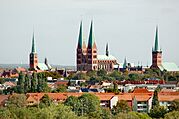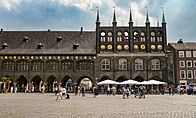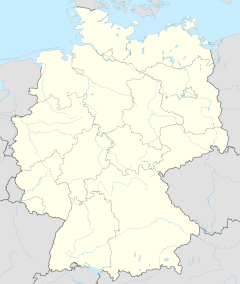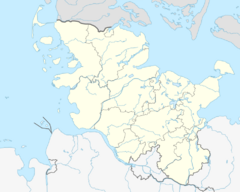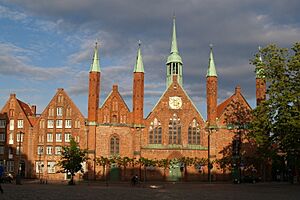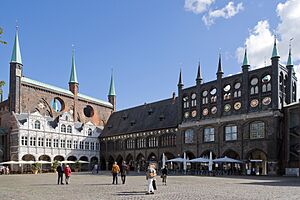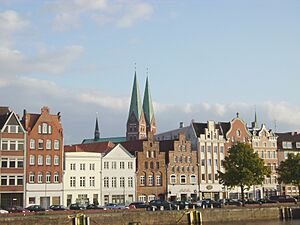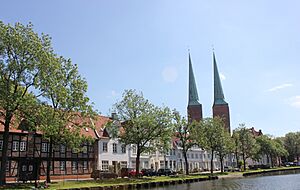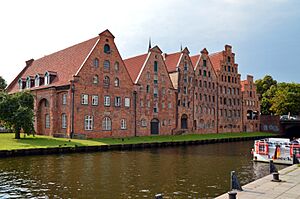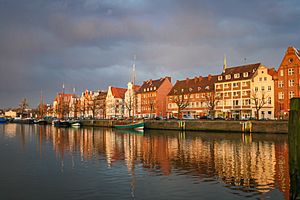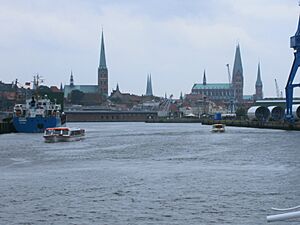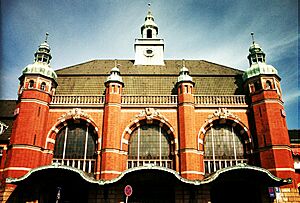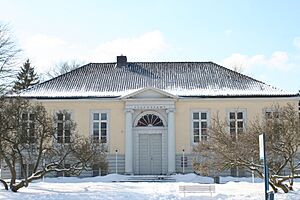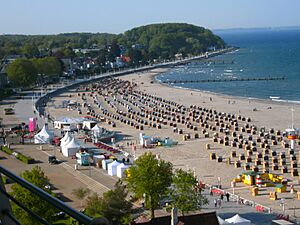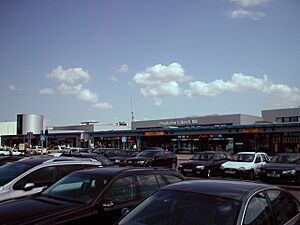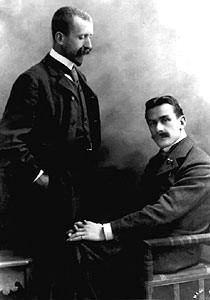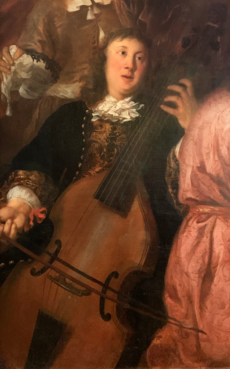Lübeck facts for kids
Quick facts for kids
Lübeck
Lübęk / Lübeek (Low German)
|
|||
|---|---|---|---|
|
St James', St Mary's and St Peter's
Holsten Gate
Lübeck City Hall
Lübeck Cathedral
An der Obertrave
Aerial view of Lübeck
|
|||
|
|||
| Country | Germany | ||
| State | Schleswig-Holstein | ||
| District | Urban district | ||
| Subdivisions | 35 Stadtbezirke | ||
| Area | |||
| • Total | 214.13 km2 (82.68 sq mi) | ||
| Elevation | 13 m (43 ft) | ||
| Population
(2022-12-31)
|
|||
| • Total | 218,095 | ||
| • Density | 1,018.517/km2 (2,637.95/sq mi) | ||
| Time zone | UTC+01:00 (CET) | ||
| • Summer (DST) | UTC+02:00 (CEST) | ||
| Postal codes |
23501−23570
|
||
| Dialling codes | 0451, 04502 | ||
| Vehicle registration | HL | ||
| UNESCO World Heritage Site | |
|---|---|

Aerial view of the old town
|
|
| Criteria | Cultural: iv |
| Inscription | 1987 (11th Session) |
| Area | 81.1 ha (200 acres) |
| Buffer zone | 693.8 ha (1,714 acres) |
Lübeck is a famous city in Northern Germany. It's often called the "Hanseatic City of Lübeck" because of its important history with the Hanseatic League. With about 220,000 people, it's the second-largest city on Germany's Baltic Sea coast. It's also the second-largest city in the state of Schleswig-Holstein, after Kiel.
Lübeck sits on the Trave River, which flows into the Bay of Lübeck. The city's historic old town is on an island, making it very special. It's the closest German city to the Baltic Sea from Hamburg. The name Lübeck comes from an old Slavic word meaning "love."
This city was once the main city of the Hanseatic League, a powerful group of trading cities in the Middle Ages. Lübeck's old town is so unique that UNESCO made it a World Heritage Site. You can see its skyline from far away, with seven tall church towers. This is why it's also known as the "City of the Seven Towers."
Lübeck is a hub for learning, with the University of Lübeck and other schools. It also has many museums, including the European Hansemuseum and a museum dedicated to Lübeck Marzipan, a sweet treat the city is famous for. The nearby beach town of Travemünde is a popular spot for visitors.
Contents
History of Lübeck
Humans have lived in the Lübeck area since the end of the last Ice Age, around 9,700 BCE. You can still find ancient stone monuments called dolmens there.
Early Settlements
Around 700 AD, Slavic people moved into the eastern part of Holstein. They founded a settlement called Liubice (meaning "how lovely") near the Trave River. This settlement became very important for a group of Slavic people called the Obotrites in the 10th century. However, in 1128, another group called the Rani destroyed Liubice.
In 1143, Adolf II of Holstein started a new German town on a river island called Bucu. He built a new castle, and the town quickly grew. In 1158, the powerful Duke Henry the Lion took over the castle. After Henry lost power in 1181, Lübeck became an independent city for a short time.
The city was ruled by a council of 20 members, mostly merchants. This meant that trade was very important in Lübeck's decisions for many centuries. The city was part of different kingdoms until 1227.
The Hanseatic League and Lübeck's Golden Age
Around 1200, Lübeck's port became a key place for people traveling to new lands around the Baltic Sea. In 1226, Emperor Frederick II made Lübeck an Imperial Free City. This meant it was independent and only answered to the Emperor.
In the 14th century, Lübeck became known as the "Queen of the Hanseatic League." It was the biggest and most powerful city in this medieval trading group. In 1375, Emperor Charles IV even called Lübeck one of the five "Glories of the Empire."
Lübeck and the Hanseatic League had some disagreements and even fights with Denmark and Norway over trading rights. Lübeck won some of these conflicts but lost a civil war in Denmark called the Count's Feud (1534–1536).
Later Years and Changes
After the Count's Feud, Lübeck's power slowly decreased. The city stayed neutral during the Thirty Years' War (1618–1648). This long war and new trade routes across the Atlantic Ocean made the Hanseatic League less important. Even after the League officially ended in 1669, Lübeck remained a key trading city on the Baltic Sea.
During the wars involving Napoleon in the early 1800s, French troops occupied Lübeck in 1806. For a few years, Lübeck was even part of France. But in 1813, allies against Napoleon freed the city.
After Napoleon's defeat, Lübeck became an independent free city again in 1815. It then joined different German groups and eventually became part of the German Empire in 1871.
20th Century and World War II
After World War I, Lübeck became a state in the Weimar Republic. However, in the 1930s, when the Nazis came to power, Lübeck lost its independence. In 1937, it became part of the larger state of Schleswig-Holstein.
During World War II, Lübeck was the first German city to be heavily bombed by the British Royal Air Force in March 1942. This attack caused a huge fire and destroyed many historic buildings, including parts of its famous churches. Over 320 people died.
In May 1945, near the end of the war, a terrible event happened in the Bay of Lübeck. RAF bombers sank three ships that were secretly packed with concentration camp prisoners. About 7,000 people died in this disaster.
After the war, Lübeck's population grew a lot. Many German refugees from eastern parts of Europe moved there. Lübeck became part of West Germany and was right on the border with East Germany during the Cold War. The city spent many years carefully restoring its historic center. In 1987, UNESCO recognized this effort by making it a World Heritage Site.
In April 2015, Lübeck hosted the G7 conference, where leaders from seven major countries met.
Climate
Lübeck has an oceanic climate, which means it has mild winters and cool summers. The Baltic Sea helps keep the temperatures from getting too extreme. In winter, the average temperature is around 2°C (36°F), and in summer, it's about 18°C (64°F). While summers are generally cooler than inland areas, there can still be some hot days.
The highest temperature ever recorded in Lübeck was 38.0°C (100.4°F) on August 9, 1982. The lowest was -27.2°C (-17.0°F) on February 4, 1912.
Population
| Historical population | ||
|---|---|---|
| Year | Pop. | ±% |
| 1350 | 18,800 | — |
| 1502 | 25,444 | +35.3% |
| 1807 | 31,450 | +23.6% |
| 1845 | 38,190 | +21.4% |
| 1871 | 48,274 | +26.4% |
| 1900 | 93,241 | +93.1% |
| 1910 | 112,890 | +21.1% |
| 1925 | 124,358 | +10.2% |
| 1939 | 154,811 | +24.5% |
| 1946 | 239,194 | +54.5% |
| 1951 | 234,960 | −1.8% |
| 1956 | 229,554 | −2.3% |
| 1961 | 236,477 | +3.0% |
| 1966 | 242,616 | +2.6% |
| 1971 | 239,761 | −1.2% |
| 1976 | 230,407 | −3.9% |
| 1981 | 219,403 | −4.8% |
| 1986 | 209,159 | −4.7% |
| 1991 | 213,847 | +2.2% |
| 1996 | 215,673 | +0.9% |
| 2001 | 213,496 | −1.0% |
| 2006 | 211,213 | −1.1% |
| 2011 | 213,112 | +0.9% |
| 2016 | 218,253 | +2.4% |
| 2021 | 216,227 | −0.9% |
| Population size may be affected by changes in administrative divisions. Source: | ||
Lübeck has about 217,000 people, making it the second-largest city in Schleswig-Holstein. It became a major city when it joined the Hanseatic League in the 15th century. After World War II, many refugees from other parts of Germany moved to Lübeck, causing its population to grow quickly.
The population dropped a bit in the 1970s but grew again in the 1990s after German Reunification. This was because many people from former East Germany moved to Lübeck, which was right on the old border. Today, Lübeck attracts many tourists who come to see its rich history and beautiful Hanseatic buildings.
Lübeck is home to people from many different backgrounds. The largest groups include people from Turkey, Ukraine, Poland, Syria, and Croatia.
| Rank | Nationality | Population (31 Dec. 2022) |
|---|---|---|
| 1. | 4,500 | |
| 2. | 2,867 | |
| 3 | 2,496 | |
| 4 | 2,363 | |
| 5 | 1,425 | |
| 6 | 1,237 | |
| 7 | 1,024 | |
| 8 | 971 | |
| 9 | 956 | |
| 10 | 724 |
Politics
The current mayor of Lübeck is Jan Lindenau from the Social Democratic Party of Germany (SPD). He was elected in 2017. The Lübeck city council works with the mayor to manage the city.
Culture
Tourism in Lübeck
Lübeck is a very popular place to visit, with over 2 million overnight stays in 2019. People love its medieval city center, with its old churches, the famous Holstentor gate, and narrow streets. Lübeck is known as "Die Stadt der 7 Türme" (the city of seven towers) because of its seven tall church towers that stand out in the skyline.
Like many German cities, Lübeck has a wonderful Christmas market in December. A special part of it is the handicrafts market inside the Hospital of the Holy Spirit, a very old building.
Famous Buildings
More than 80% of Lübeck's old town still looks like it did in the Middle Ages, with historic buildings and winding streets. The rest has been carefully rebuilt and restored. In the past, you could only enter the town through four gates, and two of them are still standing today: the well-known Holstentor (built in 1478) and the Burgtor (built in 1444).
The old town center is dominated by seven church steeples. The oldest are Lübeck Cathedral and St. Mary's Church, both built between the 13th and 14th centuries.
The Hospital of the Holy Spirit, built in 1286, is one of the oldest social institutions in the world. It still works as a retirement and nursing home today, and you can visit some of its historical parts.
Other interesting places to see include:
- The City Hall
- St. Catherine's Church, which used to be part of a monastery and is now a school.
- The houses of famous writers Thomas Mann and Günter Grass.
- Several other beautiful churches like St Peter's, St James', and St Giles's.
- The Salzspeicher, which are old warehouses where salt was stored before being shipped to other countries.
- The charming city of Travemünde on the Baltic Sea coast.
Music, Literature, and Art
Lübeck has a rich history in music. The composer Franz Tunder started weekly music performances called Abendmusiken at St. Mary's Church. Later, another famous composer, Dieterich Buxtehude, became the organist there. Many other rising composers, like Handel and Bach, traveled to Lübeck to hear him play.
The famous writer and Nobel Prize winner Thomas Mann came from a family of Lübeck merchants. His novel Buddenbrooks tells the story of life in 19th-century Lübeck.
Lübeck was also the setting for an interesting art story in the 1950s. An artist named Lothar Malskat was hired to restore old paintings in St. Mary's Church after it was damaged in World War II. Instead, he painted new ones and pretended they were old. He later admitted what he did. Another Nobel Prize winner, Günter Grass, wrote about this event in his novel The Rat.
Museums
Lübeck has many museums to explore. Some of them are the St. Anne's Museum Quarter, Lübeck, the Behnhaus, the European Hansemuseum, and the Holstentor museum. There's also a unique Lübeck Museum of Theatre Puppets. You can even visit a historic lightvessel (a ship that acts like a lighthouse) and the Lisa von Lübeck, which is a rebuilt 15th-century Hanseatic trading ship.
Don't forget the marzipan museum on the second floor of Café Niederegger. It teaches you about the history of marzipan and shows old molds and figures made from this sweet treat.
Food and Drink
Lübeck is super famous for its marzipan. One story says that marzipan was first made in Lübeck during a time when the city ran out of food, except for almonds and sugar. People used these ingredients to make marzipan "bread." However, some believe marzipan actually came from Persia much earlier. The most well-known marzipan maker in Lübeck is Niederegger, and tourists often visit their shop, especially around Christmas.
Lübeck also has a long history of trading wine. A special Lübeck wine is called Rotspon. It's made from grapes grown in France, then shipped in wooden barrels to Lübeck, where it's stored, aged, and bottled.
Like other cities on the North German coast, Fischbrötchen (fish sandwiches) and Brathering (fried pickled herring) are popular snacks because there's so much fresh fish available.
Sports
Lübeck is home to the football team VfB Lübeck, which plays in the 3. Liga. Their home stadium is the Stadion an der Lohmühle, which can hold 17,849 fans. The sports club also has teams for badminton, gymnastics, handball, and table tennis.
Education
Lübeck has three universities: the University of Lübeck, the Technical University of Applied Sciences Lübeck, and the Lübeck Academy of Music. The Graduate School for Computing in Medicine and Life Sciences is a special part of the university that focuses on computer science in health.
The Academy of Hearing Acoustics is also in Lübeck. It's Germany's main training center for people who help others with hearing aids.
Districts
The city of Lübeck is divided into 10 main areas, which are then split into 35 smaller districts. Here are some of the main zones:
- 01 City Centre (~ 12,000 people): This is the main tourist area, with the old town and former city walls. It's the oldest and smallest part of Lübeck.
- 02 St. Jürgen (~ 40,000 people): Located south of the city center, this is one of Lübeck's historic suburbs and its largest part.
- 07 St. Gertrud (~ 40,000 people): East of the city center, this area is known for its beautiful nature, including parks, rivers, and forests.
- 10 Travemünde (~ 15,000 people): This district is in the far northeast of Lübeck, right on the Baltic Sea. It has a long beach and is the city's second-biggest tourist spot.
International Friends
Lübeck has special connections with cities around the world.
Twin Towns – Sister Cities
Lübeck is twinned with:
 Kotka, Finland (since 1969)
Kotka, Finland (since 1969) Wismar, Germany (since 1987)
Wismar, Germany (since 1987) La Rochelle, France (since 1988)
La Rochelle, France (since 1988) Klaipėda, Lithuania (since 1990)
Klaipėda, Lithuania (since 1990) Visby, Sweden (since 1999)
Visby, Sweden (since 1999)
Friendly Cities
Lübeck also has friendly relationships with:
 Venice, Italy (since 1979)
Venice, Italy (since 1979) Kawasaki, Japan (since 1992)
Kawasaki, Japan (since 1992) Bergen, Norway (since 1996)
Bergen, Norway (since 1996) Shaoxing, China (since 2003)
Shaoxing, China (since 2003)
Transport
Lübeck is well-connected by roads. The A1 Motorway goes north towards the Island of Fehmarn and Copenhagen in Denmark, and south to Hamburg and Cologne. The A20 Motorway heads east towards Rostock and west towards the North Sea. The A226 Motorway connects central Lübeck to the seaport city of Travemünde.
The city has several train stations, with Lübeck Hauptbahnhof being the main one. It's the busiest station in Schleswig-Holstein, serving about 31,000 passengers daily. You can take regional trains to Hamburg, Kiel, and other places. There are also some longer-distance trains to cities like Munich.
Public buses are run by the Lübeck City-Traffic-Company. They have 40 bus lines that serve the city and its surrounding areas.
The district of Travemünde has Lübeck's main port on the Baltic Sea. The Scandinavienkai (Scandinavia Quay) is where ferries leave for places like Malmö and Trelleborg in Sweden, Liepāja in Latvia, and Helsinki in Finland. It's the second-largest German port on the Baltic Sea.
Lübeck Airport is a regional airport located south of the city. For more international flights, people often use Hamburg Airport.
Notable People from Lübeck
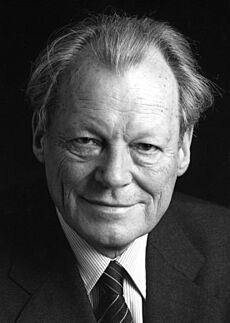
Many interesting people have come from Lübeck:
Politics
- Willy Brandt (1913–1992), a very important German politician who became the Chancellor of Germany.
- Robert Habeck (born 1969), a writer and politician.
Art and Music
- Sir Godfrey Kneller (1646–1723), a famous painter who worked for British kings and queens.
- Friedrich Overbeck (1789–1869), a painter who led an art movement.
- Dieterich Buxtehude (c.1637–1707), a well-known composer and organist.
Science and Writing
- Thomas Mann (1875–1955), a famous novelist who won the Nobel Prize for Literature.
- Heinrich Mann (1871–1950), also a novelist and Thomas Mann's brother.
- Hermann von Fehling (1811–1885), a chemist.
- Friedrich Wilhelm Gustav Bruhn (1853–1927), who invented the taximeter (the device that calculates taxi fares).
Sports
- Sandra Völker (born 1974), a swimmer who won three medals at the 1996 Summer Olympics.
- Maximilian Munski (born 1988), a rower who won a silver medal at the 2016 Summer Olympics.
See also
 In Spanish: Lübeck para niños
In Spanish: Lübeck para niños
- Lübeck Airport
- Lübeck Hauptbahnhof
- Lübeck law
- Lübeck Nordic Film Days
- VfB Lübeck, the city's football club


